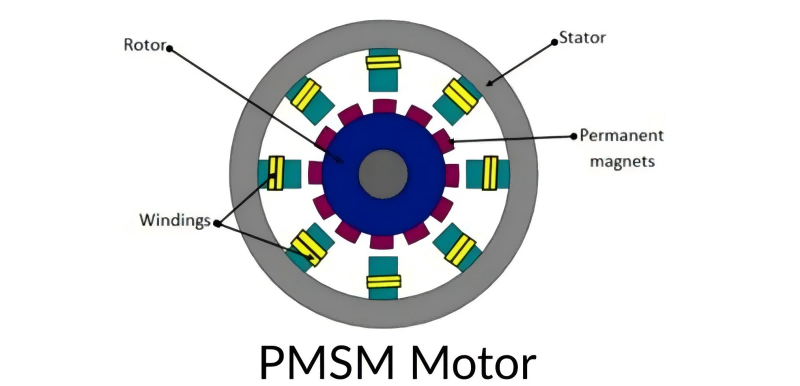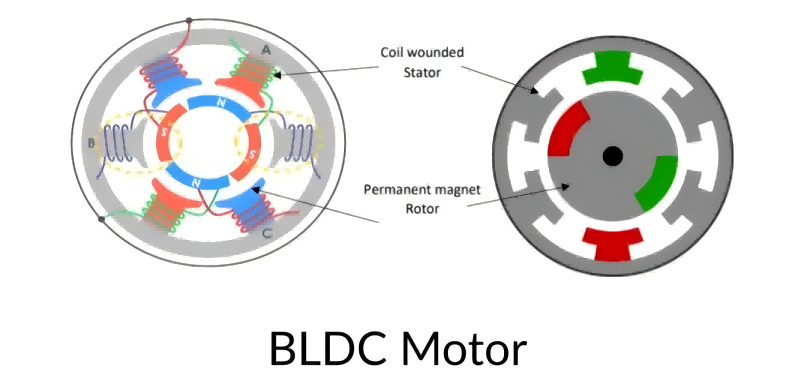In the world of electric motors, two prominent types that are widely used in various applications are the Brushless DC Motor (BLDC) and the Permanent Magnet Synchronous Motor (PMSM). Both motors are celebrated for their efficiency, compact size, and high performance, but they differ in their construction, control techniques, and application suitability. This article delves into the key differences between BLDC and PMSM motors to help users understand which motor is better suited for their needs.

Construction and Working Principles
- Brushless DC Motor: BLDC motors are synchronous motors that run without brushes and are powered by a DC electrical source. Instead of mechanical commutation found in traditional DC motors, BLDC motors use electronic commutation with the help of an inverter or electronic controller. The rotor in a BLDC motor contains permanent magnets, and the stator is equipped with coils that generate a rotating magnetic field to drive the rotor.
- Permanent Magnet Synchronous Motor: Permanent magnets are also used in the rotor of PMSM motors, however their operation is based on the synchronous speed principle. In contrast to induction motors, the rotor spins without slipping at the same frequency as the stator’s spinning magnetic field. Unlike BLDC motors, PMSM motors often rely on sinusoidal waveform control instead of trapezoidal control.
Control Techniques
- BLDC Motor Control: BLDC motors typically use trapezoidal control for commutation. In this control method, the motor is driven by a rectangular or trapezoidal waveform current, which simplifies the control electronics and is generally easier to implement. However, this control technique can lead to torque ripple, meaning the motor experiences slight variations in torque as it operates.
- PMSM Motor Control: PMSM motors are controlled using Field-Oriented Control (FOC) or Vector Control, which is more complex but results in smoother operation. This sinusoidal control method ensures that the torque remains constant throughout the motor’s operation, leading to better performance, especially in precision applications. PMSM motors are known for their smooth torque delivery and higher efficiency at variable speeds.
Stator Winding Distribution
- BLDC Motor: The stator winding distribution is typically trapezoidal, designed to create a trapezoidal back-EMF waveform. This results in six-step (commutated) operation, ideal for applications requiring precise positioning.
- PMSM Motor: The stator winding distribution is sinusoidal, creating a smooth sinusoidal back-EMF waveform. This allows for continuous rotation with minimal torque ripple, making PMSM more efficient and smoother at higher speeds.
Permanent magnet shape
- BLDC Motor: The permanent magnets are usually rectangular or trapezoidal in shape to create a trapezoidal back-EMF waveform. This shape helps optimize the commutation process in BLDC motors for efficient operation in a six-step drive system.
- PMSM Motor: The permanent magnets in PMSM motors are generally curved or sinusoidally shaped to produce a smooth sinusoidal back-EMF. This shape enhances the smoothness of rotation, improving efficiency and performance, especially in high-precision and high-speed applications.

Performance Characteristics
Efficiency:
Both BLDC and PMSM motors are highly efficient, thanks to their brushless design. However, PMSM motors often have an edge over BLDC motors in terms of overall efficiency, especially in applications that require precise speed control and high torque at varying speeds.
Speed and Torque:
BLDC motors are known for delivering high speed and high torque. They are frequently utilized in appliances, pumps, fans, and other applications where quick reaction times are crucial. However, BLDC motors can exhibit torque ripple due to trapezoidal commutation, making them slightly less suited for precision applications.
PMSM motors, on the other hand, deliver constant torque across a wider range of speeds, making them ideal for precision applications such as robotics, electric vehicles, and CNC machines. The sinusoidal control method ensures that the motor operates smoothly without torque variations, making it perfect for demanding applications that require consistent performance.
Application Suitability
BLDC Motor Applications
BLDC motors are commonly found in applications where high speed, lower costs, and simpler control electronics are required. Some typical uses include:
- Computer cooling fans
- Air conditioners
- Power tools
- Electric bicycles
The robustness and simplicity of BLDC motors make them ideal for consumer electronics and devices that operate in high-speed conditions with minimal maintenance requirements.
PMSM Motor Applications
PMSM motors are preferred in high-performance and precision control applications where efficiency and smooth operation are crucial. These applications often include:
- Electric vehicles (EVs)
- Industrial automation
- Robotics
- CNC machines
- Home appliances
The ability of PMSM motors to deliver precise control and operate efficiently at variable speeds makes them ideal for advanced technologies like EVs and industrial robots.
Cost Considerations
Because of their less complex control electronics, BLDC motors are typically less expensive than PMSM motors. Their cost-effectiveness makes them attractive for lower-end or mass-produced consumer products. However, PMSM motors, while generally more expensive due to more complex control requirements, provide better long-term efficiency and reliability in high-end applications where precision is crucial.
Advantages and Disadvantages
| Feature | BLDC Motor | PMSM Motor |
| Efficiency | High but lower than PMSM at variable speeds | Extremely high, especially at variable speeds |
| Control | Simple trapezoidal control, easy to implement | Complex sinusoidal control, smooth operation |
| Torque Ripple | Moderate, with torque variations | Very low, with constant torque output |
| Applications | Consumer electronics, cooling fans, power tools | Precision machinery, EVs, industrial automation |
| Cost | Lower initial cost, simpler control | Higher cost, better long-term efficiency |
Which Motor Should You Choose?
Choosing between a BLDC motor and a PMSM motor largely depends on the specific application and performance requirements:
- Choose a BLDC motor if you are looking for a cost-effective solution with moderate precision and high-speed operation. For example, power tools, fans, and small appliances can benefit from the fast response time and simple control of BLDC motors.
- Choose a PMSM motor if your application requires precision control, consistent torque, and variable speed performance. Electric vehicles, industrial automation, and robotics often benefit from the smooth operation and high efficiency of PMSM motors.
Conclusion
To sum up, BLDC motors and PMSM motors have their own characteristics advantages and disadvantages. Careful considerations must be made based on the unique requirements and conditions of each application when choosing a motor type. For application scenarios that require high efficiency, long life and good controllability, you can choose BLDC motors; for applications that require high control accuracy, wide speed range and good torque stability, you can choose PMSM motors.
